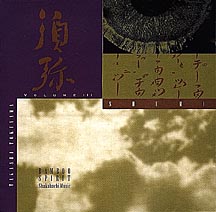

TAKASHITOKUYAMA
VolumeI III - SHUMI
1. Mukaji (20'49")
2. Yoshiya (7'52")
3. Otai (2'11")
4. Sanya (5'56")
5. Kumoijishi (9'07")
6. Hokkoku-reibo (6'37")
7. Ajikan (5'21")
Together with Koku and Kyorei (recordedon Volumes I and II), this work is treasured as one of the "threetraditional masterpieces." The story goes that a mendicant,shakuhachi- playing monk, Kichiku, while spending the night atthe temple of Kokuzodo on Mt. Asakuma in Ise, had a dream in whichhe put to sea in a boat, where, enveloped in mist, he heard thedulcet sounds of a flute. On awakening, he created this piecefrom the melody he had heard in the dream. Though it consistsof a simple, repeated phrase, the tune has a grace and eleganceabout it, and is thought to be the original melody of the shakuhachiclassical repertoire, on which many other works are based.
More than a classical piece, this songsounds like one played by a flute in a festival environment. Itmay indeed have been adapted from folk or festival music. TheKanji characters for Yoshiya are the same as those for the districtof Yoshino, known for its connection to the ancient emperor Godaigo,lord of Kusunoki Masakatsu, who was said to be the forefatherof the mendicant Komuso (Fuke Zen) priests.
It is said that when two Komuso meton the road, they would greet each other by playing this song.The first would play it in the low register (otsu) and the secondwould respond by playing the same melody in the higher register(kan). The Komuso were always on the alert for impostors and wereknown to inflict severe punishment on those who proved unableto play Otai.
This piece is representative of theMeianji school of Kyoto. Numerous other tunes by the same nameexist in the shakuhachi repertoire. The melody of this one, inparticular, resembles the traditional Koto piece Sanya sugakakiand the Nezasaha Kinpu-ryu (school) of same. The name (literally,"three valleys") is said by one account to refer tothe presence of three high-pitched passages in the song. Togetherwith Takiochi and Akita sugakaki, Sanya is one of the standardsof the orthodox school.
Kumoijishi is based on a legend of thehouse of Itcho in Hakata. The use of the special terms netoriand hyoshi define passages of the tune and suggest the influenceof Gagaku (ancient Japanese court music). The bright, metronomicquality of "lion" (inoshishi) songs like this one standsout from the free rhythm that dominates the classical shakuhachirepertoire; indeed, they appear to be based on, if not lifteddirectly from, melodies played on the flute for lion dances. Suchmelodies are said to have been played by students as afternoondiversions rather than for training. With the exception of theNezsaha school's Shishi, all of the "lion" pieces inthe repertoire - Sakejishi, Azumajishi, and the Shishi-odori andRokudanjishi of the Shinpo school - display this quality.
This piece originates from the famoustemple of Rinzai Zen Kokutaiji in Toyama Prefecture, where SuzukiDaisetsu and Nishida Ikutaro are said to have meditated. It alsogoes by the name Toppiki, after a phrase that sounds like "Toppikipi"toward the middle of the tune. On the anniversary of the deathof the founder of Kokutaiji, June 2 and 3, Komuso and priestsin full dress join together in a procession to the founder's pavilion.
Miyagawa Nyozan combined an old Kyushumelody with the unique Yuri-no-te technique of Hasegawa Kogaku,last abbott of the house of Futai, in Sendai, to create this newadaptation. Though short, it fully reveals the charm of the shakuhachi.The name Ajikan refers to a ritual of the Shingon sect of Buddhism.Tani Kyochiku, known as the last of the Komuso, is said to haveenjoyed playing this piece on a long flute, 2.5 shaku (a littleunder 2 1/2 feet) in length.
Priceof CDs / Priceof Sheet Music
![]() Volume I - Hi Kyoku
Volume I - Hi Kyoku
![]() Volume II - Korei
Volume II - Korei
![]() Volume IV - Michi
Volume IV - Michi
![]() Volume V - Kumoi
Volume V - Kumoi
![]() Tokuyama Honkyoku Sheet Music
Tokuyama Honkyoku Sheet Music
![]() Tokuyama Honkyoku Playing Guide
Tokuyama Honkyoku Playing Guide